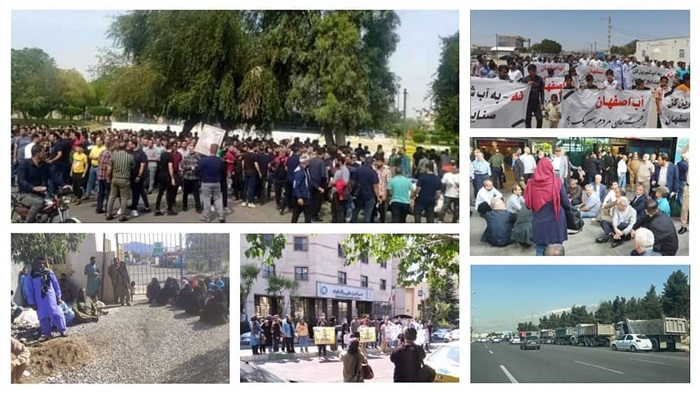

From Tehran to Kerman, discontent has manifested in demonstrations against government policies, labor conditions, and environmental concerns. Here is a breakdown of the recent protests:
In the capital city, Tehran, protests erupted on multiple fronts. Firstly, applicants awaiting delivery of Peugeot Pars cars gathered to voice frustration over delays and price hikes. Meanwhile, truck drivers took to Babayi Expressway to decry a significant reduction in their fuel rations, highlighting the economic challenges facing the transportation sector.
April 27—Tehran, #Iran
Nutrition science graduates rally in front of the health ministry in protest to new regulations that are making it difficult for them to work.#IranProtests pic.twitter.com/gZlG5ieNkU— People's Mojahedin Organization of Iran (PMOI/MEK) (@Mojahedineng) April 27, 2024
Truck drivers in Asaluyeh, southern Iran, joined the chorus of dissent, protesting against fuel ration cuts that have adversely affected their livelihoods. The demonstration in Asaluyeh reflects a nationwide trend of discontent among drivers grappling with fuel shortages and restrictions on fuel allocations.
Workers of the Iranian Offshore Oil Company resumed protests on Lavan Island, southern Iran, demanding improvements to wage policies and changes in company management. Their demonstration highlights ongoing labor disputes and dissatisfaction with working conditions in the oil and gas sector.
April 27—Shush, southwest #Iran
Workers of Pars Paper rally in front of the Shush governorate to continue protesting the dismissal of 100 of their coworkers and lack of response to their demands. #IranProtests pic.twitter.com/pp6hsbtRZ8— People's Mojahedin Organization of Iran (PMOI/MEK) (@Mojahedineng) April 27, 2024
In Shush, southern Iran, workers of Pars Paper gathered to protest the dismissal of colleagues and the lack of response to their demands. The demonstration underscores labor unrest and frustration over job security and management decisions within the paper industry.
Truck drivers in Rask, southeast Iran, staged protests against fuel ration reductions, adding their voices to the growing chorus of dissent across the country. The demonstration in Rask reflects widespread grievances among drivers over government policies impacting their ability to operate and earn a livelihood.
April 27—Babayi Expressway (Tehran), #Iran
Truck drivers on strike, protesting the significant reduction of their fuel rations. #IranProtestspic.twitter.com/RQjbf9ImgN— People's Mojahedin Organization of Iran (PMOI/MEK) (@Mojahedineng) April 27, 2024
The recent surge in protests from drivers across Iran follows reports of a burgeoning black market for fuel cards, driven by new restrictions and exorbitant prices. Truck drivers, in particular, have been vocal in their opposition to fuel ration cuts, citing economic hardships and logistical challenges. With experts warning of potential fuel price hikes due to financial constraints on fuel imports, the protests underscore deep-seated socio-economic grievances and simmering discontent within Iranian society.
On April 26, along the coast of Hormozgan Province, southern Iran, residents of Sirik protested against the construction of desalination plants, citing environmental concerns and potential disruptions to their coastal way of life.
April 27—Lavan Island, southern #Iran
Workers of the Iranian Offshore Oil Company resume protests as authorities continue to ignore their demands for changes to the wage determination policies, change in the company's management, and other basic needs.#IranProtests pic.twitter.com/jE8T5bb3t5— People's Mojahedin Organization of Iran (PMOI/MEK) (@Mojahedineng) April 27, 2024
In Kerman Province, southeast Iran, residents of the “Rameshk” area rallied against the seizure of their lands for copper mining activities. Their protest underscored environmental worries and property rights violations, reflecting broader concerns about resource exploitation and land management practices.

MEK Iran (follow us on Twitter and Facebook), Maryam Rajavi’s on her site, Twitter & Facebook, NCRI (Twitter & Facebook), and People’s Mojahedin Organization of Iran – MEK IRAN – YouTu







